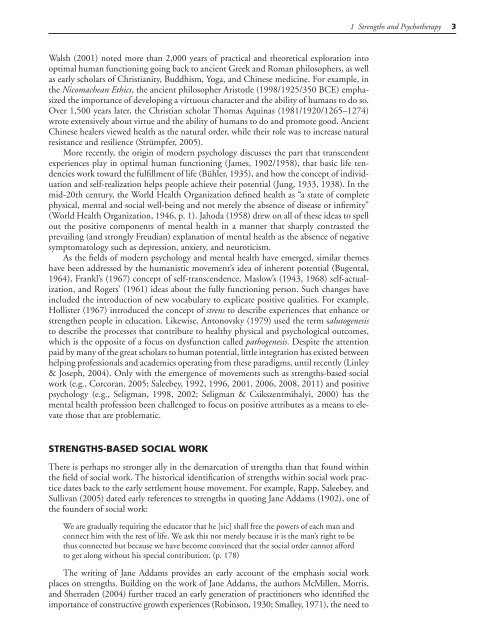Tools for Strengths-Based Assessment and Evaluation - Springer ...
Tools for Strengths-Based Assessment and Evaluation - Springer ...
Tools for Strengths-Based Assessment and Evaluation - Springer ...
Create successful ePaper yourself
Turn your PDF publications into a flip-book with our unique Google optimized e-Paper software.
1 <strong>Strengths</strong> <strong>and</strong> Psychotherapy 3<br />
Walsh (2001) noted more than 2,000 years of practical <strong>and</strong> theoretical exploration into<br />
optimal human functioning going back to ancient Greek <strong>and</strong> Roman philosophers, as well<br />
as early scholars of Christianity, Buddhism, Yoga, <strong>and</strong> Chinese medicine. For example, in<br />
the Nicomachean Ethics, the ancient philosopher Aristotle (1998/1925/350 BCE) emphasized<br />
the importance of developing a virtuous character <strong>and</strong> the ability of humans to do so.<br />
Over 1,500 years later, the Christian scholar Thomas Aquinas (1981/1920/1265–1274)<br />
wrote extensively about virtue <strong>and</strong> the ability of humans to do <strong>and</strong> promote good. Ancient<br />
Chinese healers viewed health as the natural order, while their role was to increase natural<br />
resistance <strong>and</strong> resilience (Strümpfer, 2005).<br />
More recently, the origin of modern psychology discusses the part that transcendent<br />
experiences play in optimal human functioning (James, 1902/1958), that basic life tendencies<br />
work toward the fulfillment of life (Bühler, 1935), <strong>and</strong> how the concept of individuation<br />
<strong>and</strong> self-realization helps people achieve their potential (Jung, 1933, 1938). In the<br />
mid-20th century, the World Health Organization defined health as “a state of complete<br />
physical, mental <strong>and</strong> social well-being <strong>and</strong> not merely the absence of disease or infirmity”<br />
(World Health Organization, 1946, p. 1). Jahoda (1958) drew on all of these ideas to spell<br />
out the positive components of mental health in a manner that sharply contrasted the<br />
prevailing (<strong>and</strong> strongly Freudian) explanation of mental health as the absence of negative<br />
symptomatology such as depression, anxiety, <strong>and</strong> neuroticism.<br />
As the fields of modern psychology <strong>and</strong> mental health have emerged, similar themes<br />
have been addressed by the humanistic movement’s idea of inherent potential (Bugental,<br />
1964), Frankl’s (1967) concept of self-transcendence, Maslow’s (1943, 1968) self-actualization,<br />
<strong>and</strong> Rogers’ (1961) ideas about the fully functioning person. Such changes have<br />
included the introduction of new vocabulary to explicate positive qualities. For example,<br />
Hollister (1967) introduced the concept of strens to describe experiences that enhance or<br />
strengthen people in education. Likewise, Antonovsky (1979) used the term salutogenesis<br />
to describe the processes that contribute to healthy physical <strong>and</strong> psychological outcomes,<br />
which is the opposite of a focus on dysfunction called pathogenesis. Despite the attention<br />
paid by many of the great scholars to human potential, little integration has existed between<br />
helping professionals <strong>and</strong> academics operating from these paradigms, until recently (Linley<br />
& Joseph, 2004). Only with the emergence of movements such as strengths-based social<br />
work (e.g., Corcoran, 2005; Saleebey, 1992, 1996, 2001, 2006, 2008, 2011) <strong>and</strong> positive<br />
psychology (e.g., Seligman, 1998, 2002; Seligman & Csikszentmihalyi, 2000) has the<br />
mental health profession been challenged to focus on positive attributes as a means to elevate<br />
those that are problematic.<br />
STRENGTHS-BASED SOCIAL WORK<br />
There is perhaps no stronger ally in the demarcation of strengths than that found within<br />
the field of social work. The historical identification of strengths within social work practice<br />
dates back to the early settlement house movement. For example, Rapp, Saleebey, <strong>and</strong><br />
Sullivan (2005) dated early references to strengths in quoting Jane Addams (1902), one of<br />
the founders of social work:<br />
We are gradually requiring the educator that he [sic] shall free the powers of each man <strong>and</strong><br />
connect him with the rest of life. We ask this not merely because it is the man’s right to be<br />
thus connected but because we have become convinced that the social order cannot af<strong>for</strong>d<br />
to get along without his special contribution. (p. 178)<br />
The writing of Jane Addams provides an early account of the emphasis social work<br />
places on strengths. Building on the work of Jane Addams, the authors McMillen, Morris,<br />
<strong>and</strong> Sherraden (2004) further traced an early generation of practitioners who identified the<br />
importance of constructive growth experiences (Robinson, 1930; Smalley, 1971), the need to

















